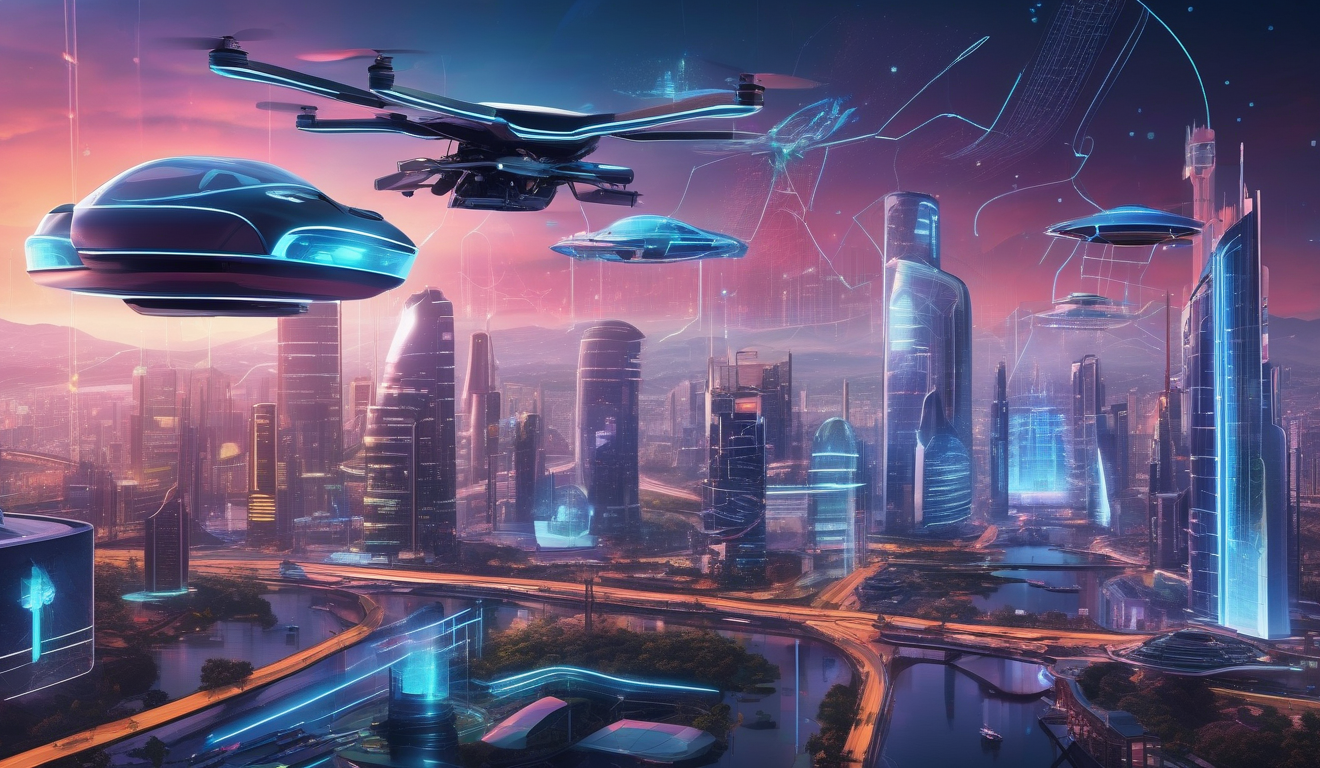Tech Predictions for the Next Decade

As we stand on the brink of a technological revolution, the next decade promises to be nothing short of exhilarating. Imagine a world where artificial intelligence not only assists us but anticipates our needs, transforming how we live and work. The rapid evolution of technology will redefine our everyday experiences, making them more interconnected and efficient. From the rise of AI to the pervasive reach of the Internet of Things (IoT), the landscape of innovation is set to reshape our reality in ways we can only begin to fathom.
Let’s dive into some of the most thrilling predictions that could reshape our lives. For starters, the integration of AI into various sectors is expected to enhance productivity and decision-making processes significantly. Think of AI as your personal assistant, capable of sifting through mountains of data to provide you with actionable insights in a heartbeat. This transformation will not only streamline operations but also raise ethical questions about data privacy and job displacement, prompting a need for thoughtful regulation.
Meanwhile, quantum computing is on the horizon, promising to tackle problems that traditional computers can only dream of solving. Imagine being able to simulate complex biological processes or optimize logistics in real-time—quantum computing could make this a reality. However, as we embrace this powerful technology, we must also confront the potential risks it poses, especially in the realm of cybersecurity. Current encryption methods may become obsolete, necessitating the development of new standards to safeguard our sensitive information.
Then there’s the explosive growth of the IoT, connecting devices in ways that will revolutionize our daily lives. Picture smart homes that anticipate your preferences or cities that optimize traffic flow in real-time. However, with this increased connectivity comes a wave of privacy concerns that cannot be ignored. It’s essential to strike a balance between innovation and the protection of personal data.
Lastly, the future of work is evolving, with remote collaboration technologies leading the charge. As businesses adapt to this new normal, understanding the tools that facilitate effective teamwork will be crucial. However, amidst the flexibility that remote work offers, we must also be aware of the challenges it presents, particularly in maintaining a healthy work-life balance.
In summary, the next decade is poised to be a whirlwind of technological advancements that will challenge our perceptions and redefine our lifestyles. Buckle up, because the future is arriving faster than we can imagine!

The Rise of Artificial Intelligence
Artificial intelligence (AI) is not just a buzzword; it’s rapidly becoming a cornerstone of innovation across various industries. Imagine a world where machines can learn, adapt, and make decisions just like humans. Exciting, right? Over the next decade, AI is poised to revolutionize sectors such as healthcare, finance, and manufacturing, enhancing efficiency and decision-making processes like never before.
As we delve deeper into the realm of AI, we must consider its potential applications. For instance, in healthcare, AI algorithms can analyze vast amounts of data to identify patterns that humans might miss. This capability can lead to earlier diagnoses and personalized treatment plans, ultimately saving lives. In finance, AI can predict market trends, enabling smarter investment strategies. However, as we embrace these advancements, we also need to address the ethical considerations that come with them. Who is responsible when an AI makes a mistake? What happens to jobs that become obsolete due to automation?
The impact of AI on the workforce is another critical aspect to consider. While some jobs may vanish, new opportunities will emerge. It’s like the evolution of the telephone; it didn’t eliminate communication jobs; it transformed them. The key is to prepare the workforce for this shift by investing in education and training programs that focus on AI literacy and skills development.
In summary, the rise of artificial intelligence is a double-edged sword. On one side, we have incredible potential for innovation and efficiency; on the other, we face ethical dilemmas and workforce disruptions. As we navigate this exciting yet challenging landscape, it’s crucial to strike a balance between leveraging AI’s capabilities and ensuring that we address the societal implications that come with it. The next decade will be pivotal in shaping how we integrate AI into our lives, and it’s a journey worth watching.

Advancements in Quantum Computing
Quantum computing is not just a futuristic dream; it’s rapidly becoming a reality that could redefine our understanding of technology. Imagine a computer that can solve complex problems in seconds, problems that would take traditional computers years to crack. This is the promise of quantum computing, and it’s exciting to think about the possibilities it brings. With advancements in this field, we are on the brink of breakthroughs that could revolutionize industries from cryptography to pharmaceuticals.
As researchers continue to push the boundaries of what quantum computers can achieve, we are witnessing a surge in interest and investment. Major tech companies and governments are pouring resources into quantum research, recognizing its potential to transform everything from data processing to artificial intelligence. One of the most significant developments is the creation of quantum bits or qubits, which allow quantum computers to perform multiple calculations simultaneously. This capability is what sets them apart from classical computers.
However, with great power comes great responsibility. As quantum computing evolves, it raises ethical questions and challenges that we must address. For instance, how will we protect sensitive information in a world where quantum computers can easily break current encryption methods? This concern leads us to consider the implications for cybersecurity. The potential for quantum computing to revolutionize industries is enormous, but it also necessitates a reevaluation of our current security measures to safeguard against its threats.
As quantum computing becomes more prevalent, it will significantly challenge existing encryption methods. Traditional encryption relies on mathematical problems that are difficult for classical computers to solve, but quantum computers can tackle these problems with ease. This shift means that cybersecurity strategies must adapt swiftly to protect sensitive information against quantum threats. The race is on to develop new encryption standards that can withstand the power of quantum computing.
The development of quantum-resistant encryption standards is crucial. Researchers are actively working on algorithms that can secure data in a quantum future. This includes exploring various mathematical foundations that quantum computers cannot easily break. The race to create robust security measures is essential to ensure that our data remains safe.
Current cybersecurity systems face significant vulnerabilities due to the rise of quantum computing. As we delve deeper into this new era of technology, it is vital to highlight the risks associated with outdated encryption methods. Organizations must proactively adapt their security infrastructure to protect data integrity, ensuring that their sensitive information is shielded from potential quantum attacks.
Impact on Cybersecurity
As we step into the future, the evolution of quantum computing is poised to create seismic shifts in the realm of cybersecurity. Imagine a world where traditional encryption methods are rendered obsolete overnight—this is the reality we may soon face. Quantum computers have the potential to process information at speeds that classical computers simply cannot match, making them capable of breaking current encryption protocols that protect sensitive data.
So, what does this mean for businesses and individuals alike? The implications are profound. With quantum technology advancing, organizations must rethink their cybersecurity strategies to safeguard against potential breaches. Here are some key areas that will be impacted:
- Encryption Vulnerabilities: Current encryption methods, like RSA and ECC, could be easily compromised. This vulnerability poses a significant risk to data integrity and confidentiality.
- Need for Quantum-Resistant Solutions: Companies will need to invest in developing and implementing quantum-resistant encryption standards to protect their data.
- Increased Cyber Threats: As quantum computing becomes more accessible, the number of cyber threats may increase, as malicious actors leverage this technology for nefarious purposes.
To combat these challenges, the cybersecurity landscape is adapting. Experts are already working on quantum-safe algorithms that can withstand the computational power of quantum machines. The development of these new standards is crucial for ensuring the security of sensitive information in a quantum future.
Moreover, organizations must conduct regular assessments of their current systems to identify vulnerabilities. This proactive approach will help them stay one step ahead of potential threats. It’s not just about keeping data safe; it’s about building a robust framework that can adapt to the rapid changes in technology.
In conclusion, as quantum computing continues to evolve, the impact on cybersecurity will be profound. Organizations must embrace change, invest in new technologies, and prioritize the development of quantum-resistant measures. The future of data security will depend on our ability to adapt and innovate in the face of unprecedented challenges.
New Encryption Standards
As we stand on the brink of a quantum revolution, the development of quantum-resistant encryption standards becomes not just important, but essential. Traditional encryption methods, which have served us well for decades, are now facing unprecedented challenges from the computational power of quantum computers. These machines can process information in ways that classical computers can’t even dream of, potentially cracking encryption codes that protect everything from our emails to our bank transactions.
Imagine a world where your sensitive information is no longer safe, where hackers can bypass security measures with ease. This is the reality we could face if we don’t adapt and innovate. The race is on to create new encryption standards that can withstand quantum attacks. Researchers are diving into various approaches, including:
- Lattice-based cryptography: This method uses complex mathematical structures that are believed to be resistant to quantum attacks.
- Hash-based signatures: These rely on the security of hash functions, which are less vulnerable to quantum threats.
- Code-based cryptography: This approach utilizes error-correcting codes to secure data.
To give you a clearer picture, let’s take a look at a comparison of traditional versus quantum-resistant encryption methods:
| Encryption Type | Vulnerability to Quantum Attacks | Current Use Case |
|---|---|---|
| RSA | High | Secure communications, SSL certificates |
| Elliptic Curve Cryptography (ECC) | Medium | Mobile devices, secure transactions |
| Lattice-based | Low | Future-proof applications, post-quantum security |
These new encryption standards are not just theoretical; they are being actively researched and developed by experts around the globe. Organizations are beginning to implement pilot programs to test these new methods in real-world scenarios. The transition won’t happen overnight, but the groundwork is being laid for a future where our data can remain secure, even in a world dominated by quantum computing.
In conclusion, as we forge ahead into this new era of technology, the importance of developing robust encryption standards cannot be overstated. It’s a race against time, and the stakes are higher than ever. Are we ready to meet the challenge?
Vulnerabilities in Current Systems
As we stand on the brink of a technological revolution, it’s crucial to recognize the vulnerabilities that current cybersecurity systems face in light of quantum computing advancements. Traditional encryption methods, which have served as the backbone of digital security for decades, are now at risk of becoming obsolete. Imagine a world where the very algorithms designed to protect our data can be cracked in a matter of seconds by a quantum computer. This isn’t science fiction; it’s a looming reality.
Current systems rely heavily on cryptographic algorithms like RSA and ECC, which are fundamentally based on mathematical problems that classical computers struggle to solve. However, quantum computers can exploit quantum bits (qubits) to perform calculations at unprecedented speeds. This means that sensitive information, such as financial records and personal data, could be exposed if we don’t adapt our security measures.
To illustrate the potential risks, consider the following:
- Data Breaches: With quantum computing, hackers could easily breach systems that rely on traditional encryption, leading to significant data leaks.
- Identity Theft: Personal information could be compromised, making individuals vulnerable to identity theft.
- Financial Fraud: The ability to decrypt sensitive financial transactions could lead to rampant fraud.
As we look to the future, it’s imperative that organizations begin to reassess their cybersecurity strategies. This means investing in quantum-resistant encryption methods, which are designed to withstand the computational power of quantum machines. Researchers are already exploring various algorithms, such as lattice-based and hash-based cryptography, that could provide a robust defense against quantum threats.
In summary, the vulnerabilities in current systems pose a significant risk as quantum computing continues to evolve. Without proactive measures and a shift in our approach to cybersecurity, we may find ourselves at the mercy of cybercriminals wielding the power of quantum technology. The time to act is now, as the future of data security hinges on our ability to adapt and innovate.
Applications in Healthcare
Imagine a world where medical breakthroughs happen at lightning speed, where diseases are diagnosed before symptoms even appear, and where personalized treatments are tailored specifically to your genetic makeup. Quantum computing is not just a futuristic concept; it’s rapidly becoming a reality that holds the potential to transform the healthcare landscape dramatically.
One of the most exciting applications of quantum computing in healthcare is its ability to accelerate drug discovery. Traditional methods of developing new medications can take years, even decades, and involve a lot of trial and error. However, with quantum algorithms, researchers can simulate molecular interactions at an unprecedented scale and speed. This means that the next life-saving drug could be discovered in a fraction of the time, potentially saving countless lives.
Moreover, quantum computing can enhance personalized medicine. By analyzing vast amounts of data from genomic sequencing and patient records, quantum systems can identify the most effective treatments for individuals based on their unique genetic profiles. This not only increases the chances of successful treatment but also minimizes the risk of adverse reactions, making healthcare safer and more efficient.
Additionally, the implications of quantum computing extend to predictive analytics. Imagine a healthcare system that can predict outbreaks of diseases before they happen, allowing for proactive measures to be taken. By processing complex datasets from various sources, quantum computers can identify patterns and correlations that would be impossible for classical computers to detect.
However, while the potential is immense, it’s essential to consider the challenges that come with it. The integration of quantum computing into healthcare must be approached with caution, addressing issues such as data privacy and the need for new regulatory frameworks. As we stand on the brink of this technological revolution, the collaboration between technologists, healthcare professionals, and policymakers will be crucial to ensure that these advancements benefit everyone.
In conclusion, the applications of quantum computing in healthcare are not just theoretical; they are poised to redefine how we approach medicine. As we embrace this technology, we move closer to a future where healthcare is more effective, personalized, and proactive than ever before.

The Expansion of the Internet of Things (IoT)
The Internet of Things, or IoT, is on the verge of a massive expansion that promises to transform our daily lives in ways we can barely imagine. Picture a world where your refrigerator can order groceries, your thermostat adjusts itself based on your habits, and your car communicates with traffic systems to find the quickest route. Sounds like science fiction, right? Well, it’s becoming a reality, and the implications are enormous.
As more devices become interconnected, the benefits of IoT will permeate various aspects of our lives. For instance, in homes, smart devices can enhance energy efficiency, improve security, and provide convenience. In industries, IoT can optimize operations, reduce costs, and enhance productivity. However, with these advancements come challenges that we must address to fully harness the potential of IoT.
One of the most significant benefits of IoT is the ability to collect and analyze data in real-time. This capability allows businesses to make informed decisions quickly, leading to better outcomes. For example, in agriculture, IoT sensors can monitor soil conditions and crop health, enabling farmers to optimize their yields. Similarly, in healthcare, connected devices can track patient vitals and alert medical staff in emergencies.
However, the rapid expansion of IoT raises serious concerns regarding privacy and security. With billions of devices collecting data, the potential for breaches and misuse of personal information increases. Therefore, it’s crucial to implement robust security measures to protect user data. Here are some key challenges and considerations:
- Ensuring device security against hacking
- Maintaining user privacy while collecting data
- Creating standards for interoperability among devices
Moreover, as we dive deeper into the world of IoT, the concept of smart cities emerges. By integrating IoT technology, cities can improve public services, enhance transportation systems, and reduce energy consumption. Imagine traffic lights that adjust in real-time based on traffic flow or waste management systems that optimize collection routes. These innovations not only make urban living more efficient but also contribute to sustainability efforts.
In conclusion, the expansion of the Internet of Things is set to revolutionize our world. While the benefits are vast, addressing the challenges that come with this technology is crucial. As we embrace this new era, it’s essential to prioritize security and privacy to ensure a safe and efficient IoT ecosystem for everyone.
Smart Cities Development
The concept of smart cities is rapidly gaining traction as urban areas strive to become more efficient and sustainable. Imagine a city where traffic flows smoothly, energy consumption is minimized, and public services are tailored to meet the needs of the residents. This vision is not just a dream; it is becoming a reality through the integration of Internet of Things (IoT) technologies. Smart cities leverage a network of interconnected devices to collect and analyze data, which can then be used to enhance urban living.
One of the most significant benefits of smart city development is the improvement of infrastructure. For instance, intelligent traffic management systems can reduce congestion by adjusting traffic signals in real-time based on current traffic conditions. This not only saves time for commuters but also lowers emissions, contributing to a cleaner environment. Furthermore, smart lighting systems can automatically adjust brightness based on the presence of pedestrians, ensuring safety while conserving energy.
However, the journey to becoming a smart city is not without its challenges. Implementation requires substantial investment in technology and infrastructure, which can be difficult for many municipalities. Additionally, there are concerns regarding data privacy and security. As cities gather vast amounts of data from their residents, safeguarding this information becomes crucial. To address these issues, city planners and technology developers must work together to create robust frameworks that prioritize both innovation and security.
Moreover, smart cities can foster greater community engagement. With mobile applications and online platforms, residents can provide feedback on services, report issues, and participate in decision-making processes. This level of involvement can lead to a more connected and informed citizenry, ultimately enhancing the quality of life.
To summarize, the development of smart cities is a multifaceted endeavor that holds immense potential for the future. By embracing technology and prioritizing sustainability, urban areas can transform into vibrant, efficient spaces that cater to the needs of their residents. As we look ahead, the collaboration between government, businesses, and citizens will be key to unlocking the full potential of smart city initiatives.
Privacy Concerns
As the Internet of Things (IoT) continues to expand, the surrounding personal data security are becoming more pronounced. With billions of devices interconnected, the potential for data breaches and unauthorized access increases exponentially. Imagine your fridge not only keeping your food fresh but also sharing your dietary habits with third-party companies. Sounds convenient, right? But at what cost?
One of the most alarming aspects of IoT is the sheer volume of data being collected. From smart home devices to wearable technology, our everyday actions are being monitored and recorded. This data can include everything from our health metrics to our daily routines. While this information can enhance user experience and provide valuable insights, it also raises significant questions about who has access to this data and how it is being used.
To put it into perspective, consider the following:
- Over 50 billion IoT devices are expected to be in use by 2030, each collecting data that could be vulnerable to exploitation.
- Many consumers are unaware of the extent to which their information is shared, often agreeing to terms and conditions without fully understanding the implications.
- Data breaches in IoT devices can lead to identity theft, financial loss, and a breach of personal privacy.
Moreover, the lack of standardized regulations across different regions complicates the situation. Companies often prioritize innovation and speed over privacy, leading to products that may not adequately protect user data. As a result, consumers are left in the dark about their rights and the measures they can take to safeguard their information.
To combat these issues, it’s essential for individuals to take proactive steps. Here are a few strategies to consider:
- Regularly update device firmware to patch vulnerabilities.
- Utilize strong, unique passwords for each device.
- Be selective about the data you share and with whom.
Ultimately, as we embrace the convenience of IoT, we must also advocate for stronger privacy protections. The future of technology should not come at the expense of our personal security. It’s time to demand transparency and accountability from manufacturers, ensuring that our data remains ours and ours alone.

The Future of Remote Work
Remote work is not just a passing trend; it’s a revolution that is reshaping the business landscape. As we look towards the future, it’s clear that the way we work will continue to evolve, driven by technology and changing attitudes towards work-life balance. Imagine waking up, sipping your morning coffee, and logging into your office from the comfort of your home—this is the new normal that many are embracing. But what does this mean for businesses and employees alike?
One of the key factors fueling this change is the advancement of technology. Tools that facilitate remote collaboration have become more sophisticated, allowing teams to communicate seamlessly, regardless of their physical location. From video conferencing platforms to project management software, these innovations are making it easier than ever to maintain productivity. For instance, platforms like Zoom and Trello are becoming staples in remote work environments, enabling teams to stay connected and organized.
However, while remote work offers unparalleled flexibility, it also presents unique challenges. The lines between personal and professional life can easily blur, leading to potential burnout. Employees might find themselves answering emails late into the night or working through weekends. To combat this, companies must prioritize work-life balance and encourage their teams to set boundaries. Here are a few strategies that can help:
- Establish clear working hours and encourage employees to unplug after hours.
- Promote regular breaks to recharge and avoid fatigue.
- Encourage open communication about workload and mental health.
Looking ahead, the future of remote work will likely see an increase in hybrid models, where employees split their time between home and the office. This approach not only provides the best of both worlds but also fosters a sense of community and collaboration. Companies that adapt to this new model will be better positioned to attract and retain top talent.
As we navigate this exciting evolution, it’s essential to remain adaptable and open-minded. The future of remote work is bright, filled with opportunities for innovation and growth. Embracing these changes can lead to a more productive, satisfied workforce, ultimately benefiting both employees and employers.
Tools for Collaboration
As we navigate this new era of remote work, having the right is essential. These tools not only facilitate communication but also foster a sense of community among team members who may be miles apart. Imagine trying to build a house without the right tools—frustrating, right? The same goes for remote work; without effective collaboration tools, productivity can plummet.
One of the most popular tools is Slack, a messaging platform that allows teams to communicate in real time. It’s like having a virtual office where you can chat, share files, and even integrate other apps to streamline your workflow. With channels for different projects, it helps keep conversations organized. Another vital tool is Zoom, which has become synonymous with video conferencing. It brings the human touch back into remote work, allowing for face-to-face interactions that can enhance team dynamics.
But it doesn’t stop there. Project management tools like Trello and Asana are game-changers. They allow teams to track tasks, set deadlines, and visualize progress, making it easier to stay on top of projects. Here’s a quick comparison of some popular collaboration tools:
| Tool | Primary Function | Best For |
|---|---|---|
| Slack | Messaging and Communication | Real-time team chats |
| Zoom | Video Conferencing | Virtual meetings and webinars |
| Trello | Project Management | Visual task organization |
| Asana | Task Tracking | Deadline management and team collaboration |
However, while these tools can significantly enhance productivity, it’s crucial to remember that they are just that—tools. The real magic happens when teams actively engage with one another. Regular check-ins, virtual coffee breaks, and team-building activities can help maintain morale and connection. After all, it’s not just about getting the work done; it’s about creating a thriving work culture, even from a distance.
In conclusion, the future of remote work is bright, thanks in part to innovative collaboration tools. By embracing these technologies and fostering genuine connections, teams can not only survive but thrive in this new landscape.
Work-Life Balance Challenges
In today’s fast-paced world, the shift to remote work has brought about a new set of challenges, especially when it comes to maintaining a healthy work-life balance. Imagine working from home, where your office is just a few steps away from your couch. Sounds convenient, right? But this proximity can blur the lines between professional responsibilities and personal time, leading to a chaotic mix of both.
One of the major hurdles faced by remote workers is the inability to “switch off.” Unlike traditional office settings, where you physically leave work at the end of the day, working from home can make it all too easy to keep your laptop open and your mind racing with tasks long after hours. This constant connectivity can lead to burnout, stress, and a sense of being perpetually on call.
To combat these challenges, many individuals are adopting strategies to help maintain that crucial balance. Here are a few effective approaches:
- Set Clear Boundaries: Designate specific work hours and stick to them. Communicate these hours to your colleagues to manage expectations.
- Create a Dedicated Workspace: Establish a physical space in your home that is solely for work. This helps to mentally separate work from personal life.
- Take Regular Breaks: Schedule short breaks throughout the day to recharge. This can improve focus and productivity.
- Unplug After Hours: Make a conscious effort to disconnect from work-related communications outside your designated hours.
Additionally, businesses play a crucial role in supporting their employees’ work-life balance. Offering flexible hours, encouraging time off, and fostering a culture that values mental health can make a significant difference. It’s essential for companies to recognize that their employees are not just workers; they are individuals with lives outside of their jobs.
As we move forward in this new era of work, it’s vital to prioritize our well-being. After all, a healthy work-life balance not only benefits individuals but also enhances overall productivity and job satisfaction. So, let’s embrace the flexibility that remote work offers while also setting boundaries that protect our personal time.
Frequently Asked Questions
- What are the main benefits of Artificial Intelligence in the coming decade?
Artificial Intelligence is set to enhance efficiency across various industries, making decision-making faster and more accurate. Imagine a world where machines can analyze data in seconds, providing insights that help businesses thrive. It’s like having a super-smart assistant at your fingertips!
- How will quantum computing impact cybersecurity?
Quantum computing will challenge existing encryption methods, potentially exposing sensitive data. As these powerful computers become mainstream, we’ll need to adapt our cybersecurity strategies to safeguard information. Think of it like upgrading your locks when you realize a master key exists!
- What role will the Internet of Things (IoT) play in smart cities?
The IoT will be the backbone of smart cities, connecting various devices to improve infrastructure and services. This means everything from traffic management to energy efficiency will be optimized, creating urban environments that are not just smarter but also more livable.
- How can remote work affect work-life balance?
While remote work offers flexibility, it can blur the lines between personal and professional life. It’s crucial to establish boundaries to maintain a healthy balance—like setting specific work hours and creating a dedicated workspace to keep your personal life separate from work.
- What technologies are essential for remote collaboration?
Innovative collaboration tools like video conferencing apps, project management software, and instant messaging platforms are vital for remote teams. They help maintain communication and streamline workflows, making it easier to work together, no matter where you are.













